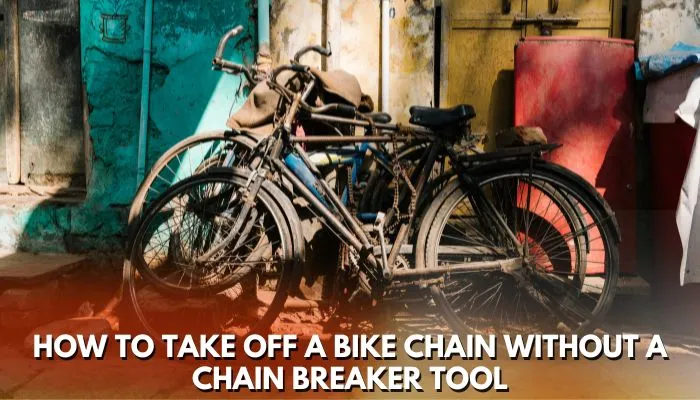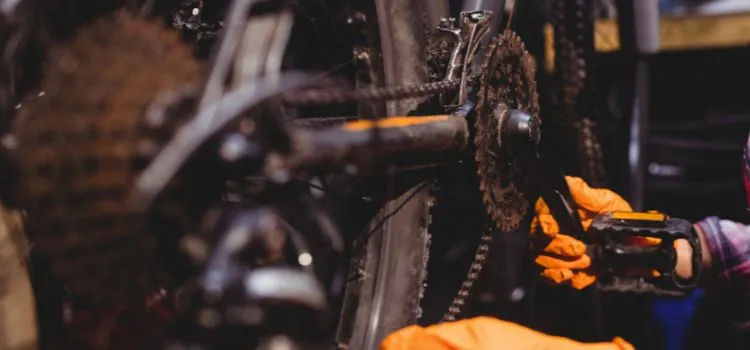Best 3 Ways To Prevent Your Bike From Rusting

Any bike may experience rust problems, but you may minimize the likelihood of damage by properly taking care of your bike and keeping it in the appropriate locations. When left outside, a bike, which is a common item, immediately turns into an abomination.
And to make matters worse, rust can damage the metal frame of your bike to the extent that it ends up breaking. Sadly, you might not have an option if you have to leave your bike outside. Nobody wants to do that.
Table of Contents
Short Answer:
Maintain the moisture level on your bike. If your bike gets wet, make sure to dry it out fully before storing it because water will make it rust. Second, use a lubricant to retain the lubrication and clean bike parts. Last but not least, you should buy a bike cover if you regularly keep your bike outside to shelter it from the weather conditions.
How To Keep A Bike From Rusting? 3 Easy Steps
Your bike may be completely destroyed by rust, making it worthless. Rust is the term for a chemical reaction that takes place when oxygen and harmful chemicals interact with metals. Any uncovered metal on your bike is vulnerable to rusting from things such as water, salts, and many other elements.
If you don’t take action to stop rust, it can spread very quickly, nibble away at metals, and lead to permanent harm. Thankfully, there seem to be steps you can take to try and prevent rust on your bike. Nobody wants their bike to be destroyed by rust, yet this could happen if you don’t take the appropriate measures. If any components on your bike are entirely corroded, you must replace them.
Your bike may avoid rusting by following these three steps.
- Dry off your bicycle.
Iron oxide, which is rust’s scientific name, is generated when iron and oxygen interact in the presence of humidity or other moisture in the air. Keeping your bike clean and dry is one of the best approaches to stop it from rusting. Spend some time wiping off the complete bike before keeping it if you recently went for a ride on a wet day or if you rode through puddles.
It is considerably more likely for a bike to rust when it is wet. We are aware of the need you could have after a long journey to just put on your bike without wiping it, but resist the urge! Before putting it away, devote some time to clean it dry.
- Maintain Oil and Lubrication on Your Bike
If you own a bike, you should constantly have a stock of bike lube on hand. The lubricant on your bike will act as a shield against the outside elements and the metal. It shouldn’t rust as far as there is a tiny amount of lubrication covering visible metal, such as the chain on your bike.
In order to avoid rust, you should keep the parts of your bike well-oiled and lubricated. Apply lubricant generously to the chain, derailleur, uncovered metal on the nuts and bolts, and essentially wherever else. To avoid using a degreaser—which constitutes an entirely different product, instead of a bike lube, be cautious about paying attention to the label.
- If outside, keep your bike covered.
The likelihood of your bike rusting will grow if you keep it outside for an extended time. We all agree that it would be ideal to be able to store our bikes inside when they are not in use, but we also understand that not everyone has this opportunity.
How rapidly your bike corrodes will be determined by the environment where you dwell. There’s a good risk that your bike could start to rust if it’s left outdoors for a long enough period of time if you reside in a place with a lot of moisture, rain, or snowfall.
The gears and chain won’t run as efficiently, and rust might cause parts to stop functioning. The frame will become less structurally sound if it begins to rust. The purchase of a bike covering (or tarp) to cover your bike is strongly advised if you intend to leave your bike out there at night.
In order to prevent snow, rain, mist, or moisture from falling on your bike, you need to have a bike covering that is large enough. Your bike will be dry if you use a decent cover. Also, it can shield your bike from the sun, which can lead the plastic parts on your bike to break and the coloration on bikes to fade.
Solutions For Rust Removal From The Bike

Because the bike shop would be far away or you may not always have the store’s cleaners and lubricants at home, you may not be capable of taking your bike in for frequent tune-ups. Don’t be frightened; we’ve equipped you with easy tips and DIY solutions to resist corrosion and preserve the condition of your bike for an extended period of time.
Simply use these commonly available materials to clean your bike of dust and rust before covering it with a protective layer.
- Sand the components
To get rid of any rust on your bike, try using steel wool, sandpaper, or a hard bristle brush. It would be best if you thoroughly cleaned your bike of even the tiniest traces of rust because it can spread quickly to other metal parts. To prevent rust from forming on any of the metal components, sand them all.
- Put pieces in cola.
All of the bike’s removable components are accessible by unscrewing them and dipping them in Coke. The grease, dust, and rust on the parts are all excluded by the acidic activity of the Coke. Despite the fact that it can also remove the lubricants, you may continue to require to grease the parts before reattaching them.
- Utilize aluminum foil.
If there are any parts that cannot be removed, you can use aluminum foil or Coke to eliminate the rust from the metals. Just tear up some small pieces of aluminum foil and put them to use to clean the bike. You may additionally utilize vinegar, citric acid, or a salt solution as cleaning solutions to replace cola.
- Procedure using baking soda
At a 50/50 proportion, you can also make a thick paste by mixing water and baking soda. Apply it to the bike’s body, wheel rims, and all other problematic areas, then let it sit for a few minutes. After 15 to 20 minutes, you may use a toothbrush or scrubbing pad to remove the rust from the harmed parts and then rinse them.
- Put a Layer of Paint On
It is typically recommended to paint a preventative coat of paint over the corroded parts once you have eliminated the rust from them. To cover the damaged places and prevent rust from migrating to the metal components once more, you may use either normal spray paint that you would use on furnishings or walls or even just use nail polish. For protection, apply a small coating of Vaseline or oil to the bike’s parts as well.
How Long Until Parts Begin To Degrade?
Depending on where your bike is, deterioration can take a variety of time frames to appear. Is it frequently damp or exposed to direct sunlight? Let’s assume the worst and say that it ends up taking corrosion around a month to produce substantial damage.
You may have to wait between three and four months before any damage to your bike is apparent if you live somewhere that has reasonably ideal climatic conditions and your parts are mid-range or higher.
Cons of Outdoor Bike Storage

There are drawbacks to leaving your bike outside, unfortunately. If you fail to properly store your bike outside or keep it out for an extended amount of time, it can damage the parts of your bike, in addition to creating a simpler way for robbers to steal it.
- The bicycle may corrode.
Your bike is susceptible to rusting in the winter. It’s extremely likely that the metal on the bike will start to rust because of the humidity in the air brought on by snow and rain. In order to prevent damage from these temperature factors, it is essential that you store your bike in a secure place.
- The colors might deteriorate.
Another instance where safeguarding your bike is more essential than ever would be during hot weather. Your bike’s colors are no different from those of other things in fading because of the sun’s Ultraviolet radiation. When you’re not using your bike, keep it out of the sun to maintain its fresh look for as long as possible.
- The bicycle’s plastic may break down.
The plastic on your bike oxidizes in the sunshine and will ultimately disintegrate if it is subjected to elevated temperatures for a prolonged period of time. The bike’s components may degrade and possibly cease to function as efficiently as they should. Hence, bear this in mind when deciding where to keep your bike. Always ensure that you keep it out of direct sunlight.
Think About Bringing It Indoors.
Consider hanging it from the ceiling if you don’t have space to attach it to the floor or a wall. It might seem impossible to store your bike on the ceiling, but it’s actually not that tough. Of course, if your bike has hydraulic disc brakes, you can’t hang it vertically or upside down. Yet there are various methods for hanging a bike from a ceiling that is appropriate for every kind of bike, such as mountain bikes.
FAQs:
Can I leave my bike in the sun without it becoming damaged?
Certain bike parts may become damaged by UV radiation when directly exposed. The brake hoods, cable casing, and other rubber elements could degrade, even if the structure were unaffected. When maintained in the sun, tires may also begin to crumble.
Does it not make sense to ride a bike in the rain?
No. In fact, biking in the rain can be a very enjoyable experience if you are ready for it. Biking in the rain won’t cause your bike to oxidize and start corroding right away. What would be detrimental is if you rode your bike through the rain without stopping to clean off the rainwater when you ended. Rust on your bike builds up over time, so a simple ride on a rainy day won’t do it as much as you wipe your bike afterward.
How can rust be completely stopped?
The most popular method for preventing rust on metals is using sandpaper to scratch or brush the metal surface. Applying phosphoric acid to rusted iron directly causes the red iron oxide to convert into black ferric phosphate, which is yet another technique for eliminating rust.
Conclusion:
Rust is just like an infection in that it may quickly spread from a specific point to every aspect of your bike, leaving you unable to identify what went bad. Now you know how to keep a bike from rusting. You must keep an ongoing check on the metal parts of your bike and conceal and eradicate any rust particles if you notice them to keep it in top condition and ensure smooth running.
Also, maintain the bike dry and clean to prevent rust from having a smooth landing. To prevent your bike from rusting outside, regularly clean its parts, apply preventive polish, and oil the engine systems. You can make your bike endure for years and operate like new by performing tiny, normal operations. These actions will also save you from major difficulties and costly repairs.
